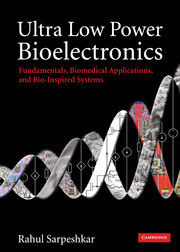Book contents
- Frontmatter
- Contents
- Acknowledgements
- Section I Foundations
- Section II Low-power analog and biomedical circuits
- Section III Low-power RF and energy-harvesting circuits for biomedical systems
- Section IV Biomedical electronic systems
- Section V Principles for ultra-low-power analog and digital design
- Section VI Bio-inspired systems
- 23 Neuromorphic electronics
- 24 Cytomorphic electronics: cell-inspired electronics for systems and synthetic biology
- Section VII Energy sources
- Bibliography
- Index
- Epilogue
- References
23 - Neuromorphic electronics
from Section VI - Bio-inspired systems
Published online by Cambridge University Press: 02 December 2010
- Frontmatter
- Contents
- Acknowledgements
- Section I Foundations
- Section II Low-power analog and biomedical circuits
- Section III Low-power RF and energy-harvesting circuits for biomedical systems
- Section IV Biomedical electronic systems
- Section V Principles for ultra-low-power analog and digital design
- Section VI Bio-inspired systems
- 23 Neuromorphic electronics
- 24 Cytomorphic electronics: cell-inspired electronics for systems and synthetic biology
- Section VII Energy sources
- Bibliography
- Index
- Epilogue
- References
Summary
It is the unification and simplification of knowledge that gives us hope for the future of our culture. To the extent that we encourage future generations to understand deeply, to see previously unseen connections, and to follow their conviction that such endeavors are noble undertakings of the human spirit, we will have contributed to a brighter future.
Carver MeadBiological systems are the most energy-efficient systems in the world. For example, the ~ 22 billion neuronal cells of the brain dominate the ~14.6 W brain power consumption of an average 65 kg male. These numbers imply a power consumption of ~ 0.66 nW per neuron. The hybrid analog-digital brain performs at least 6 ×1016 FLOPS (floating-point operations per second) such that its energy efficiency is a staggeringly low 0.24 fJ/FLOP. This energy efficiency is about 5–6 orders of magnitude more efficient than that of even the most energy-efficient digital microprocessor or digital signal processor ever built. The human eye's retina consumes nearly ~ 3.4 mW, making the 135 million photoreceptor array in the eye the lowest power wide-dynamic-range imager and image compressor ever built. The retina in the eye performs sophisticated analog gain control, analog spatial filtering, and analog temporal filtering such that nearly ~ 36 Gb/s of wide-dynamic-range raw image data from its photoreceptor array is compressed to ~ 20 Mb/s of useful optic-nerve spiking output information.
- Type
- Chapter
- Information
- Ultra Low Power BioelectronicsFundamentals, Biomedical Applications, and Bio-Inspired Systems, pp. 697 - 752Publisher: Cambridge University PressPrint publication year: 2010
References
- 3
- Cited by



